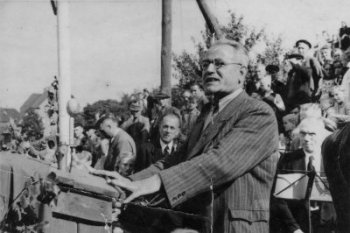Homepage Renate and Klaus Kuhl - Sailors' revolt in Kiel
Sailors' revolt in Kiel - Igniting the November Revolution 1918 in Germany

Recollection of Karl Artelt 1958:
Karl Artelt and Lothar Popp were the leaders of the marines' mutiny in Kiel 1918. As opposed to Popp, who left the army in 1917 (he remained mobilized), Artelt served for the "1. Torpedodivision" in Kiel-Wik, where he had to work in the repair yard for torpedo-boats. Like Popp he was a member of the USPD [Independent Socialdemocratic Party of Germany], but in 1919 he became a member of the KPD [Communist Party of Germany] and later in the GDR he wrote down his recollections in form of an article for the volume "Vorwärts und nicht vergessen - Erlebnisberichte aktiver Teilnehmer der Novemberrevolution 1918/1919". Here we present some excerpts, highlighting some of the lesser known incidents of that time (translation Klaus Kuhl):
In front of the Kaiser-Cafe we suddenly received MG-fire. Our demonstration stopped. When we realized that nobody was hit, we moved on. After that the MG-shooters fired directly into our demonstration. Forty to fifty demonstrators, among them also women and children, collapsed under the bullets. Eight of them were killed and 29 injured severely (see footnote below).
The people screamed in indignation and protest. After the murderers, who were under the command of Leutnant Steinhäuser, ... were not ready to stop shooting, a marine jumped in front and hit Leutnant Steinhäuser with the butt. ... Young marines and workers charged the position of the mashine gunners and put them to flight.
The next morning (4.11.1918, Klaus Kuhl) all troops in Kiel had to line up for inspection. ... After the usual reports, the division commander, Kapitän zur See Bartels, entered a specifically brought table and made a speech .. He narrated yesterdays incidents, also said that the air was charged with high voltage, but that a soldier had to abstain from politics, because he could not comprehend politics. After he had left the table, ... I didn't think twice and jumped up. I also made a short speech and requested the marines to elect soldiers' councils (Soldatenräte). Officers, trying to shoot me from the table, were recklessly disarmed by marines' fists. Thereafter we charged our arms arsenals and elected soldiers' councils in all companies. I was elected chairman of the soldiers' council.
Shortly after we received a note, that I should see the Gouverneur immediately. We got a car clear, fetched a huge red flag from a torpedo boat, which was larger than the car and prepared for the departure.
When we entered the Gouverneur's office, I realized that he almost had to force himself to negotiate with us. ... He came towards us and said: "I thank you, that you found the heart, to come here." Before we entered into negotiations with him, I asked him, as to whether he would acknowledge us as the elected soldiers' fiduciaries and would negotiate with us on an equal basis. Forced by the real facts he answered with "Yes". I now explained to him, that we first had to solve the questions being in his power. At the same time I warned him however .... to bring forward infantry against the revolutionary marines. In this case we had ordered the III. Geschwader, to fire at the officers quarter Düsternbrook and to put everything to wrecks ... he immediately made the declaration in my presence, not to deploy any outward troops and send back those being already transported ... . In addition he informed us that the member of the Imperial parliament Noske and Imperial secretary Haußmann would come to Kiel, to negotiate further with us.
In the evening we received the information, that despite of the Gouverneur's declaration four outward infantry units were advancing. We immediately jumped into our car and drove towards the infantrymen. At the General Post Office we met. We talked to them ... Thereafter I requested them, .... to either give off their arms or join the revolutionaries. The infantrymen, ... joined our revolutionary movement. The officers were disarmed.
Regarding as to why Noske got relatively free hand in Kiel, Artelt answered questions of GDR marines in the 60ties (according to Robert Rosentreter, "Blaujacken im Novembersturm", Dietz Verlag, 1988, S. 250 f.):
When asked these questions by members of the Volksmarine (peoples marine of the GDR) Karl Artelt had stressed repeatedly, that he and other comrades became only bit by bit aware of Noske's role through his conduct. Artelt himself and others ... knew, that Noske belonged to the right wing of the party, nevertheless they regarded him as a socialistic party official and hoped he would make a policy being useful for the workers during the revolution, no way someone would have thought by that time, he could be prepared to order workers to be shot ....This question (as to why the councils allowed Noske into a leading position) was also answered by Lothar Popp in an interview in 1978. See >>
Annotation: Regarding the number of dead and casualties see Dähnhardt: "Revolution in Kiel", Wachholtz Verlag, 1978, pages 65 and 66; according to official documents there were 7 people shot dead. There were no women nor children among the casualties. One woman had died a short time before within the demonstration when she was run over by a tram. Two of the wounded died some days later. Thus altogether 10 people died in connection with incidence of the 3rd November.
According to Dähnhardt's studies there was no mashine gun used but rifles "only".


